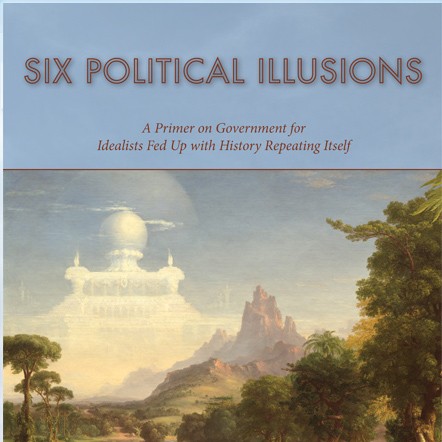By James L. Payne
Politicians are busy these days (talking about) trying to fix deficits, trying to close the gap between what government spends and what it takes in. It’s a difficult task, but it is assumed that in the long run some combination of spending cuts and tax increases will bring us to balanced budgets. If that day ever arrives, the politicians will toast each other for their maturity and leadership, and assume that the country’s fiscal problems have been solved.
Unfortunately, this self-congratulation would not be justified. In this balanced budget situation, with taxes fully covering expenditures, there would still be a huge negative number eating at the heart of national finances. This other “deficit” consists of the overhead costs, or waste, in government tax-and-spend systems.
Though there is an element of redistribution in many spending programs, basically government is taxing people and then trying to return the money to them as some benefit they could have bought for themselves, such as education, housing, art, pensions, medical care, and so on. This cycling of funds through government involves enormous waste. My estimate of this loss puts it at $5.7 trillion.
For most people a waste figure of this magnitude will seem unbelievable. How should we explain their incredulity? Perhaps their skepticism is justified. This would be true if comprehensive studies of the overhead cost of government transfers were well known and these studies consistently showed that this cost is quite small. Unfortunately this explanation is doubly false. First, the studies that do exist are obscure, utterly unknown to reporters, politicians, and the public. Second, these obscure studies indicate that overhead costs of government transfer programs are extremely high.
For example, economist Edgar Browning has taught and researched in the field of public economics for decades. In 2008 he produced a book, Stealing from Each Other, which reviewed some of the overhead costs involved in social welfare spending and the taxes that finance it. This book has an Amazon sales rank of 830,878, which is to say there are nearly a million book titles more popular.
The few people who have read it will know that Professor Browning’s estimate of the cumulative waste stemming from welfare state transfers is not a trivial number. He estimates that this waste lowers the U.S. gross domestic product (GDP) by $4 trillion.
 It is clear, then, that people who believe that the overhead costs of government activities are low do not know this for a fact. Instead they are making a blind assumption, supposing that government is an efficient machine for directing society’s resources. In Six Political Illusions I call this belief the illusion of the frictionless State.
It is clear, then, that people who believe that the overhead costs of government activities are low do not know this for a fact. Instead they are making a blind assumption, supposing that government is an efficient machine for directing society’s resources. In Six Political Illusions I call this belief the illusion of the frictionless State.
Explaining this deeply rooted bias would take us rather far afield, into realms of psychology and even theology. In summary we can say that human beings are apparently disposed to believe in a higher power capable of managing society and fixing its problems, and this leads them to thoughtlessly attribute special powers and capacities to government. One of these special powers is the ability to transfer resources without significant overhead cost.
The power of this illusion is seen in the thinking of academics and philosophers who for generations have urged government to redistribute wealth from rich to poor. None of these otherwise intelligent people paused to seriously analyze the overhead costs of such a transfer system. It did not occur to them that a system of income redistribution might involve staggering waste, indeed so much waste that even the poor end up worse off. An example of this complacency is the prominent economist Richard Musgrave, who in 1969 suggested that the overhead cost of raising a dollar in taxes was a mere two cents. Decades of economic research since he mentioned that figure have revealed that the real waste caused by the tax system alone is over 20 times as high.
Extraction Costs
To get an idea of what a full accounting would look like, let’s review some of the main overhead costs of government subsidy programs.
On the tax side the process of extracting money from the public includes these burdens:
1. Disincentive costs. A fine—for speeding, say—is a monetary penalty intended to discourage the activity that triggers the fine. In economic terms a tax is just like a fine: It discourages the economic activity that triggers the tax. A tax on wages is like a fine on working: It is a monetary penalty that discourages work. A tax on income from opening a new business is like a fine on opening new businesses, and so on.
Because of its discouraging effect on work, savings, and investment, taxation depresses production and therefore makes everyone poorer. Economists have made estimates of this cost (which they call “excess burden” or “deadweight loss”). Their figures for different taxes range from 28.7 percent to 139 percent of the taxes collected.
2. Compliance costs. The tax system compels businesses and individuals to engage in a huge amount of work to learn about the tax code and grapple with tax returns, tax reporting, and tax depositing. One study of this burden found that tax compliance labor absorbed 10.2 billion hours a year, equivalent to the entire labor force of Indiana, Iowa, and Maine put together.
3. The disincentive cost of tax uncertainty. Because taxes are an uncertain and changing future cost, firms and individuals cannot plan efficiently.
4. Enforcement costs. This is the burden on citizens of grappling with IRS accusations, including dealing with audits, tax litigation, tax liens, and forced collections.
5. Evasion and avoidance costs. This is the work and expense involved in structuring lives and businesses to minimize tax burdens, including arranging tax shelters of many kinds.
6. Governmental costs. This is the cost of running the IRS, as well as the fractional use the tax system makes of other governmental units, including the Treasury, courts, and prisons.
In a study I undertook in 1993, I found that these six costs amounted to 65.01 percent of tax revenue collected. In that report I noted the existence of 25 other tax system overhead costs that a fully comprehensive analysis ought to include.
Disbursement Costs
Once government has got the tax dollars, many kinds of wastes and costs enter the disbursement process, so that the country seldom gets one dollar of benefit for one dollar appropriated. There are seven main disbursement costs.
1. Government administrative costs. These include the costs of running the agency that oversees the subsidy as well as the fractional burden on other parts of government, including the Treasury, law enforcement units, courts, prisons, and the legislature.
2. Misallocation costs. Government agencies that attempt to deliver goods and services are inherently inefficient, owing to the fact that they are sheltered from the discipline of the market and also because political management is disruptive and demoralizing. One study of this waste found it averaged 50 percent of the funds appropriated. Government trash collection, ambulance service, and so forth cost twice as much as the same activity performed by a private firm.
Overconsumption and Underconsumption
3. Overconsumption costs. When government offers services below their economic cost, people “consume” more than they need and would be willing to pay for. This problem is especially acute when a subsidy is delivered as a producer-controlled giveaway. Medicare is an example. Since doctors are largely making the decisions and they know their patients are not paying, they can load up the bill with marginally important services. For example, in one case I know of, a consumer paying his own way arranged with his doctor for a hip replacement operation that cost $15,000.
When the same operation was being paid for by Medicare, the patient and his doctor accepted extras that brought the bill to $45,000. The pattern of overconsumption in subsidized medical care was documented in a social experiment by the RAND Corporation in the early 1980s. It found that making medical care free produced an overconsumption rate of 44 percent compared to those paying their own way—with no difference in health benefits for the average participant.
4. Underconsumption costs. An exclusive government program may fail to supply goods or services that members of the public need and are willing to pay for. For example, if a government health care monopoly fails to offer a hip replacement operation that the consumer is willing to buy for $15,000, then this $15,000 represents an underconsumption cost. Underconsumption is not a major problem in a free economy. In a State-controlled economy it is an enormous cost.
5. Private-sector compliance costs. To obtain government benefits, recipients have to undertake much work and expense, filling out forms, gathering data to put in forms, making phone calls, writing letters, standing in line, and hiring lawyers. Once the subsidy is achieved, the recipient may have to answer questionnaires and file reports. For example a North Dakota wheat farmer told me he spends 15–20 percent of his working day dealing with government paperwork connected with his farm subsidy.
6. Lobbying costs. When government is seen as capable of providing a multitude of goods and services, citizens expend time and money on lobbying, public relations and propaganda, and campaign finance to influence the political process in their favor.
7. Disincentive costs. Government benefits can undercut the motivation of both firms and citizens to be productive. For example disability payments undermine the incentive of disabled people to seek work. Unemployment benefits have a similar effect. Researchers at the Federal Reserve Bank of San Francisco found that the extension of unemployment benefits in 2009 increased unemployment by 0.8 percentage points. In other words, the disincentive effect of this benefit kept 1.2 million workers out of the labor force.
Most people work in order to have money to buy things they need. As government fills those needs through benefit programs, it takes away the incentive to work. The cumulative disincentive effect of benefit programs—food, housing, day care/schooling, medical care, retirement income—is to create a sizable body of permanently unemployed workers not contributing to the nation’s wealth.
What might these seven costs add up to? This is a complicated question because each program will have a different mix of costs. Yet because we don’t have a secure calculation of this number doesn’t mean we should proceed to treat it as zero—which the illusion of the frictionless State invites us to do. That is like saying that since we don’t know when the next train is coming, it’s safe to sleep on the tracks.
A Start
The better way to deal with this unknown is to make preliminary estimates, and then refine them with subsequent research. In the case of these overhead costs of disbursement, a useful first estimate can be achieved by proposing plausible figures for the range of each cost and taking the midpoint of each.
My effort along these lines is given in Table 1. The total, 51 percent, is a preliminary estimate of the average disbursement cost. For those who wish to criticize this number as being either too high or too low, I say: Be my guest! It’s high time that policy analysts and budget writers started making estimates of this number.
We are now in a position to make a comprehensive estimate of the overhead cost of government spending programs. On the tax side there is a 65 percent waste, and on the disbursement side a 51 percent waste, for a total of 116 percent. The interpretation of this figure, then, is that when government spends $100, the country winds up being $116 poorer than it would have been had that taxing and spending not occurred.
To calculate how much this waste costs the country overall, we need to apply it to government spending at all levels. From this total figure I have subtracted spending for core government functions—defense, foreign policy, courts, police—on the grounds that only government can provide these services.
These programs may involve huge amounts of waste, but abandoning them isn’t considered an option. All other government services— education, scientific research, pensions, health care, charity, arts, roads—can be and are provided through voluntary, free-market systems, so a realistic and less wasteful way of providing the activity is available.
Total non-core spending for federal, state, and local governments combined was $4.9 trillion in 2009–10. Applying the 116 percent factor to this number gives us a waste figure of $5.7 trillion.
That is the yearly economic loss the country suffers owing to its decision to supply consumer goods and services through government.
Translated to the individual level, this waste amounts to $18,000 per person, or $72,000 for a family of four. Next time a politician urges a government spending program to ease burdens on citizens, keep this figure in mind. Think what American families would be able to afford if government stopped trying to make things affordable.
————————–
Contributing editor James Payne has taught political science at Yale,Wesleyan, Johns Hopkins, and Texas A&M. His latest book is Six Political Illusions: A Primer on Government for Idealists Fed Up with History Repeating Itself.







